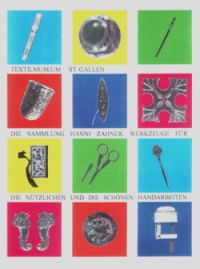The Hanni Zahner Collection
utensils for useful and beautiful needlework
In early 1993, the St.Gallen
Textile Museum was given a variety of needlework
utensils, which had been collected with a great deal of
love and expert knowledge.
The utensils from the late 18th, the 19th and the early
20th centuries constitute a wealth of cultural heritage
and provide the key to women's domestic activities. There
is a rich diversity of such utensils, graced with
valuable ornamentation, often designed as a souvenir
rather than intended for intensive use. Some of these
textile utensils are inconceivable without the emerging
fondness for travel by post coach and railway between
1800 and 1900.
In the exhibition, the needlework utensils are allocated
to the textile techniques of which they are typical. This
is not all, however: the exhibition reveals how the
upbringing of 19th c. girls was strongly oriented towards
training in domestic matters. A woman's role was clearly
defined: she was the head of the internal household. She
had to be able to master all the textile techniques. In
addition, she had to be a good wife to her husband and a
good mother to her children. Up to the early 20th
century, women were hardly ever expected to have
professional careers.
